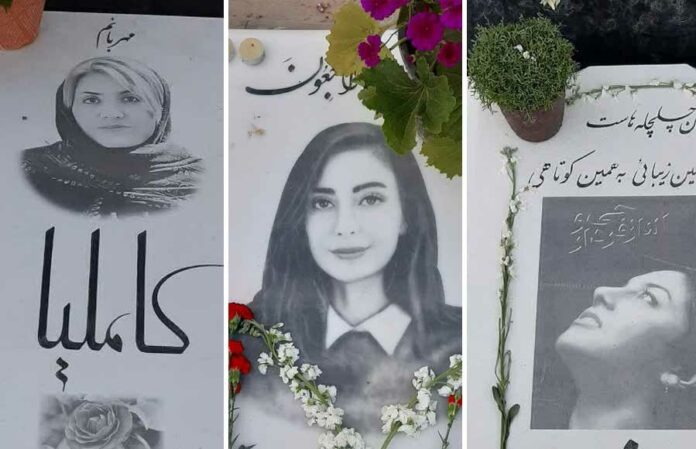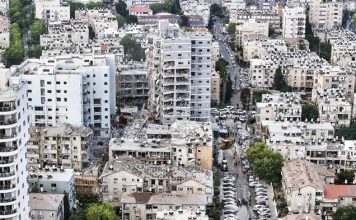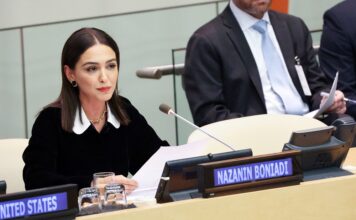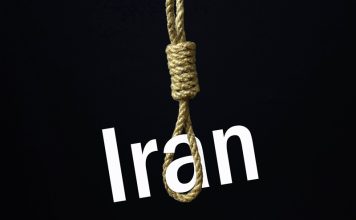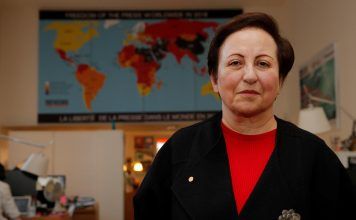By Kayhan Life Staff
The headstones of 98 graves in Behesht-e Zahra cemetery picturing the deceased wearing “improper or no hijab” were removed, the Managing director of Behesht-e Zahra Organization, Saeed Ghazanfari, said on July 26.
Behesht-e Zahra, the largest cemetery in Iran, is in the southern part of Greater Tehran.
The move comes days after a July 12 nationwide demonstration in which girls and women across Iran removed their headscarves in public, defying the mandatory hijab rule imposed by the government. July 12 marks “Hijab and Chastity Day” in the Islamic Republic of Iran.
The ultraconservative government of President Raisi has systematically tried to push women out of the workforce, ordered the Morality Police (Guidance Petrol) to enforce the Hijab law aggressively, urged senior managers to enforce mandatory “hijab and chastity” measures in government offices and banks, promoted child marriage, banned female spectators from football matches, arrested female musicians, and withheld all legal, psychological, and financial support to victims of domestic abuse and rape.
[aesop_image img=”https://kayhanlife.com/wp-content/uploads/2021/07/2021-03-31T074814Z_480402814_RC27MM9LYOK3_RTRMADP_3_HEALTH-CORONAVIRUS-IRAN-scaled.jpg” panorama=”off” credit=”FILE PHOTO/A general view of a cemetery, in south of Tehran. REUTERS./ ” align=”center” lightbox=”on” captionsrc=”custom” captionposition=”left” revealfx=”off” overlay_revealfx=”off”]
Several techniques are used to transfer a person’s photograph to their headstone or gravestone. The image is sandblasted, etched (photoblast), or attached as a ceramic photoplaque to the headstone.
“In coordination with the families of the deceased, 98 headstones with pictures [of the deceased] wearing no hijab were removed and corrected in recent months,” the Tehran-based Hamshahri Online reported quoting Mr. Ghazanfari. “We have been clear, from the start, about our position on the pictures of people wearing improper or no hijab, even though anti-revolution and opposition media have criticized and insulted us and made fun of the measure.”
“Many families whose loved ones are buried [in Behesht-e Zahra] have also complained about headstones and gravestones of religious people being decorated with non-Islamic images,” Ghazanfari explained. “We stand by our beliefs. It is inappropriate for a cemetery, the final resting place for religious people, to have gravestones with pictures of pious women wearing improper or no hijab. These are old gravestones. We have been vigilant and ensured the new headstones’ designs follow the rules.”
“We warned sellers and installers that we will sever our business ties with them, and they cannot operate [in the cemetery] if any of the pictures on the gravestones violate the hijab rule,” Ghazanfari noted.
“We inform the families about the rules before the burials and have them sign the relevant documents,” Ghazanfari explained. “However, some people put a picture of a deceased woman wearing no hijab on a gravestone.”
“We will not be confrontational in our approach and aim to make these changes with the understanding and cooperation of the families of the deceased,” he added. “We have consulted the families and will correct these pictures with their help and consent.”
Forcing families to “correct” the picture on the gravestones of their loved ones is part of a broader effort by the hardline government of President Ebrahim Raisi to remove women’s inalienable human and civil rights and make them second-class citizens.
There have also been incidents of graves of women being vandalized.
In October 2019, an unknown person or persons vandalized several graves in Royan Cemetery in the northern province of Mazandaran, covering the pictures of the deceased women on the headstones with paint.
“Several people who had gone to Royan Cemetery on Thursday [Oct. 21] to pray at the gravesite of their loved ones discovered the photos on the headstones were covered with paint,” the Islamic Republic News Agency (IRNA) reported. “Only graves of deceased women were reportedly desecrated.”
“The distraught family of the deceased demanded the cemetery’s management to investigate the incident and find out what happened,” IRNA said.
“I was shocked to see my mother’s picture covered with paint when I visited her grave on Thursday,” Fatemeh Haji Ahmadi, whose mother’s headstone was vandalized, told IRNA’s reporter. “No one gave us an explanation. However, we later heard that the cemetery’s management had approved the measure, arguing that having pictures of women on gravestones violated religious laws.”
“It is noteworthy that all the pictures on gravestones covered with paint were of older women wearing complete hijab,” IRNA added.

